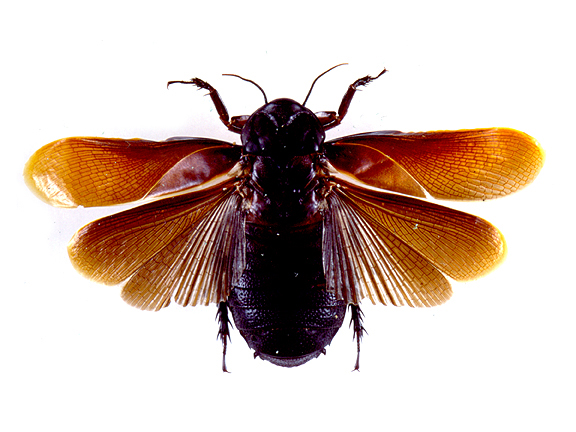Blattodea (=Blattaria) - The Cockroaches
Cockroaches evolved very early in Earth's zoological history, sometime in the Carboniferous period, about 345 million years ago. They share a common lineage with early Orthopterans, apparent by the ovipositors present in ancient cockroach fossils. They have changed little since branching off to form their own order, about 300 million years ago. Roaches have become a very successful group of insects and can be found almost everywhere on land that there is organic matter for them to feed on (except Antarctica). They were gifted with an elegant biological design, one that has endured through generation after generation of cockroaches without number. Their long antennae bear an array of sense hairs. These bristles, which detect moisture and pressure, also serve as the basis for the senses of sight, taste, and touch. Bristle-studded maxillary palpi sample molecules of potential food on an even deeper level, checking for toxic compounds. Vibration sensors in the knees and pressure-sensitive hairs on the legs can trigger nerve impulses to run in about half a second; faster than a human can blink. Although there are thousands of different species of cockroaches that do not interact with humans, a few have managed to exploit human settlements as a source of food and shelter. The German and American Cockroaches have become the insect equivalent of the rat and the mouse; easily moving into artificial, indoor environments and the network of underground tunnels beneath cities, they thrive off the leavings of humans gathered in these close quarters. Spread out among the far-flung corners of the Earth, the other nearly 3,500 species eke out a living in a myriad of other ways. Many species live in caves, beneath ground litter and in other dark places or else are completely nocturnal. Their aversion to light earned them the Latin name "Blatta", meaning, "insect that shuns light". In fact, there are roaches that live in hollow logs eating rotten wood (Cryptocercus spp.) that are quite possibly the ancestors of termites. Conversely, there are roaches that live high up in the canopies of rainforests, their lifecycles linked to the pollinating of flowers. There are roaches that swim through desert sand, roaches that can roll up into balls like armadillos and roaches that mimic beetles. There are roaches in the Neotropics that are 9cm (3.5”) in length and look almost exactly the way roaches looked 300 million years ago (Megaloblatta longipennis). Tough little critters, some roach species are capable of surviving for a few days with their head cut off (the insect eventually dies of dehydration). Some species can go a month without water and three months without food. Cockroaches are hemimetabolous (exhibiting incomplete metamorphosis) but growth rates vary. German cockroaches can reproduce rapidly, the young maturing in a few months, while giant cockroaches may take several years to mature.
 Death's Head Cockroach (Blaberus craniifer)
Death's Head Cockroach (Blaberus craniifer)
 Giant Cockroaches (Blaberus giganteus)
Giant Cockroaches (Blaberus giganteus)
 Oriental Cockroach A.K.A. Shad Roach AKA Common Cockroach (Blatta orientalis)
Oriental Cockroach A.K.A. Shad Roach AKA Common Cockroach (Blatta orientalis)
 German Cockroach (Blattella germanica) - With Egg Case
German Cockroach (Blattella germanica) - With Egg Case


